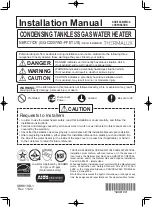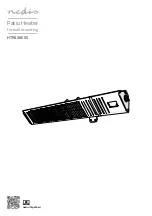
13
Please note the following:
DO NOT
install this water heater with iron piping. The
system should be installed only with piping that is
suitable for potable (drinkable) water such as copper,
CPVC, or polybutylene. DO NOT use PVC water piping.
DO NOT
use any pumps, valves, or fittings that are not
compatible with potable water.
DO NOT
use valves that may cause excessive restric-
tion to water flow. Use full flow ball or gate valves only.
DO NOT
use 50/50 tin-lead solder (or any lead based
solder) in potable water lines. Use 95/5 tin-antimony or
other equivalent material.
DO NOT
tamper with the gas valve/thermostat, igniter,
thermocouple, or temperature and pressure relief valve.
Tampering voids all warranties. Only qualified service
technicians should service these components.
DO NOT
use with piping that has been treated with
chromates, boiler seal, or other chemicals.
DO NOT
add any chemicals to the system piping which
will contaminate the potable water supply.
Closed System/Thermal Expansion
Periodic discharge of the temperature and pressure relief
valve may be due to thermal expansion in a closed water
supply system. The water utility supply meter may contain a
check valve, backflow preventer or water pressure reducing
valve. This will create a closed water system. During
the heating cycle of the water heater, the water expands
causing pressure inside the water heater to increase. This
may cause the temperature and pressure relief valve to
discharge small quantities of hot water. To prevent this, it
is recommended that a diaphragm-type expansion tank
(suitable for potable water) be installed on the cold water
supply line. The expansion tank must have a minimum
capacity of 1.5 U.S. gallons for every 50 gallons of stored
water. Contact the local water supplier or plumbing
inspector for information on other methods to control this
situation.
Important: Do not plug or remove the temperature and
pressure relief valve.














































